Technology & Innovation
How to optimize a SaaS monetization strategy to drive revenue
Do you know the essentials of SaaS monetization? We’ll show you how to build and implement an effective monetization strategy.

For product-centric CEOs and Founders, creating and delivering software products is not enough to ensure a successful business. To generate revenue, a well-defined monetization strategy is necessary.
For the first finance hires and CFOs, finding and implementing the best monetization strategy for your company can feel like a tall order–because it is. You can have an extremely popular product, but user demand and sales volume alone aren’t enough to guarantee long-term, sustainable profits. Only a well-planned product monetization strategy can do that.
In this article, we will provide a comprehensive guide to optimizing your SaaS monetization strategy. We will explain what SaaS monetization is and its importance in driving revenue, and provide actionable tips on how to build a successful monetization plan. Whether you are a B2B SaaS company or a mobile app developer, this guide will provide valuable insights to help you maximize profitability and create a positive customer experience.
What is monetization strategy?
Monetization strategy refers to the pricing model and billing decisions you make to generate revenue from a product or service. In the software industry, It’s particularly critical for companies to consider different monetization strategies, because doing so can diversify their revenue streams, facilitating different cash flow rhythms than just monthly subscriptions. This is especially true for SaaS companies, which rely on recurring revenue from subscriptions to sustain their business.
The ideal monetization strategy for your business should involve finding the right balance between generating revenue and providing a positive customer experience. Effective monetization methods include three core components:
1. It feels like a genuine win for your customers. Even though the end goal of a monetization strategy is to drive revenue, it shouldn’t feel that way to your customers. Nothing increases buyer resistance like a bold-faced cash grab. Any strategy you put in place should create a better user experience by offering a genuine benefit.
2. Your monetization strategy should capitalize on your unique market and business situation. When it comes to SaaS monetization, your choices should be guided by the specific realities of your market, industry, and customers.
3. It boosts revenue while carrying minimal costs. This aspect of your monetization strategy is crucial. If your revenue-boosting technique has high upside potential without being resource-intensive, you can be relatively confident you have a good idea.
A monetization strategy that has these core components can help increase customer loyalty, improve profitability, and drive business growth.
With that in mind, let’s look at some specific SaaS monetization strategies that can help you optimize your cash flow.
5 ways to monetize a product (strategy and models for SaaS)
There are several ways to monetize a product, and SaaS businesses have a wide range of methods to choose from. Here are five common app monetization strategies/models to help point you in the right direction.
1. Subscription model
This model involves charging customers a recurring fee for access to a core product or service. This can include monthly or yearly subscriptions. Examples of SaaS companies that use the subscription model include Netflix, Dropbox, and Adobe Creative Cloud.
2. Freemium model
This model involves offering customers a free to download limited version of a SaaS solution, while charging for premium features or additional functionality. Examples of SaaS companies that use the freemium model include LinkedIn, Mailchimp, and Hubspot.
3. Pay-per-use model
This model involves charging customers based on how much they use the product or service. This can be based on the number of users, transactions, or other metrics. Examples of SaaS companies that use the pay-per-use model include Amazon Web Services and Salesforce.
4. One-time purchase model
This e-commerce model involves charging customers a one-time fee for access to a SaaS solution. Revenue is generated through app purchases or digital products. Examples of SaaS companies that use the one-time purchase model include Microsoft Office and Adobe Photoshop.
5. Advertising model
This model involves generating revenue through app advertising. Digital advertising takes the lion’s share of most companies’ marketing spend these days. Selling ad space allows you to capitalize on that trend. And there’s another reason you should consider the advertising model as a SaaS monetization strategy: If you give out a free subscription option for your users or a free trial period, selling ad space on the free portion of your product is a great way to encourage customers to upgrade. This helps shorten your customers’ buying cycle and accelerates your cash inflows. Examples of SaaS companies that use the advertising model include Google and Facebook.
No matter which SaaS monetization tactic or combination of tactics you choose, be sure to carry out some revenue forecasting first. You should never blindly launch into a monetization plan without being able to justify it in advance with robust financial forecasts. Choose a monetization strategy that aligns with your business goals and provides a sustainable revenue stream.

Let’s move on to one of your other central components in creating a long-term winning strategy for SaaS revenue.
Pricing: the untapped growth lever
Lowering sales resistance is vital when it comes to increasing revenue and building a monetization strategy. And one of the major resistance points for SaaS buyers is pricing.
Pricing plays a crucial role in any SaaS monetization strategy. It can significantly impact revenue growth, customer acquisition, and retention. A well-designed pricing strategy can help SaaS businesses unlock untapped growth potential.
In the SaaS industry, pricing models can range from simple flat-rate pricing to more complex value-based pricing models. Accounting departments should do everything possible to optimize your pricing. Below, we’ll explain the details of SaaS pricing and how to turn pricing into part of your winning strategy for growth.
What is a SaaS pricing strategy?
A SaaS pricing strategy is a framework used to determine the price of a SaaS solution. This includes determining the price point, pricing model, and any pricing tiers or packages.
The goal of this strategy is to create a pricing model that maximizes revenue–and delivers value back to customers. A successful pricing strategy should be based on customer value, competition, and your company’s business model and goals.
There are several pricing models that SaaS businesses can use. A few examples of the most popular SaaS pricing strategies include:
- Per-user pricing: This method charges customers based on the number of users who have access to the product or service. This is common for SaaS businesses that provide B2B software solutions for teams.
- Usage-based pricing: This method charges customers based on the amount of usage or consumption of the product or service. Usage-based billing is an approach that also plays well with other billing options for hybrid billing. This is common for SaaS companies that provide cloud-based service or API solutions.
- Value-based pricing: This method charges customers based on the value that the product or service provides to them. This is common for SaaS businesses that offer solutions that save time, increase efficiency, or provide other tangible benefits to customers.
- Tiered pricing: This method offers different pricing tiers based on the features or functionality of the product or service. For this SaaS pricing strategy to work, each ascending tier needs to unlock more value for customers. This is common for companies that offer software solutions with multiple levels of functionality.
When choosing the right pricing strategy for your SaaS business, consider factors such as target audience, product niche, and competition. It’s important to strike a balance between generating revenue and providing value to customers.
Knowing your various pricing options is necessary, but insufficient as a SaaS CFO. It’s your job to ensure long-term profits by constructing and implementing an optimal SaaS pricing strategy. But how should you do that?
How automated accounting tools help with pricing decisions
SaaS finance leaders increasingly rely on automated accounting tools to help them with pricing decisions. Doing so will give you confidence and peace of mind through every phase of developing your SaaS monetization strategy.
Cloud-based revenue forecasting
Manual forecasting is unreliable, inefficient, and exposes companies to costly mistakes. Financial forecasting in the cloud is as simple as plugging in your starting data to get instant long-range forecasts. No SaaS monetization plan should go into action without being checked against automated forecasts.
Fully automated financial reporting
After your monetization strategy goes live, your board will expect a full report on your results. Automated financial reporting leaves no stone unturned, with granular drill-down options on every transaction.

Here are two more important aspects of SaaS pricing.
Embrace evidence-based segmentation
The more thoroughly you understand your customers, the better you can serve them. That’s the idea behind evidence-based segmentation, which involves dividing your customers into groups based on their characteristics.
CFOs use accounting software to create segmentation-based revenue growth strategies. By knowing about your customers’ usage habits and the various needs they’re meeting through your product, you can tailor your SaaS monetization strategies to your most profitable buyer segments.
The right method: Value-based pricing
Awareness of the specific value you offer your customers–and charging for your product in alignment with that value–is a central part of any winning strategy for pricing. Your heightened customer value could involve seamless integrations with other systems, meeting your customers’ needs more effectively than your competitors, or something else entirely.
Whichever pricing method you decide on, remember that effective SaaS monetization strategies unlock genuine value for all involved.
Build a winning strategy to evolve your subscription monetization strategy
Sage Intacct helps SaaS companies optimize their product monetization strategy and billing approach. Automation allows CFOs and finance teams to capitalize on their SaaS metrics, track real-time transaction data, and much more.
Maximizing profitability with the right monetization strategy
Embracing automation has the potential to do more for your monetization strategy than almost any other factor. You’ll be able to accomplish more in less time with fewer resources, which will free you up for high-level strategizing about your SaaS monetization plan.
Maximizing profitability with the right subscription billing strategy
Just as significantly, cloud-based accounting software will help you boost profitability with a rock-solid subscription billing strategy.
To learn more about developing your SaaS monetization strategy, check out this visual infographic: 5 Steps to Building Your B2B Subscription Billing Strategy.







Ask the author a question or share your advice